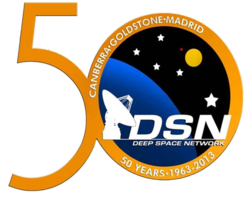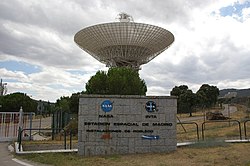Deep Space Network
The Deep Space Network (or DSN) is NASA's group of large antennae at three stations around world. They are at Madrid, California, and Canberra,[1] about 120 degrees apart around the Earth. They communicate with satellites and probes in space. The antennas are also used as radio telescopes to learn about stars and other natural things in space.
The DSN is NASA’s international array of giant radio antennas. It supports interplanetary spacecraft missions, plus a few that orbit Earth. It also provides radar and radio astronomy observations that improve the understanding of the solar system and the larger universe.[1]
According to NASA, "The antennas of the Deep Space Network are the indispensable link to explorers venturing beyond Earth. They provide the crucial connection for commanding our spacecraft and receiving their never-before-seen images and scientific information on Earth, propelling our understanding of the universe, our solar system and ultimately, our place within it."[1]
The placement of these sites allow communication with spacecraft as our planet rotates. Before a distant spacecraft sinks below the horizon at one DSN site, another site can pick up the signal and carry on communicating. All three sites have at least four antennae stations. Each are equipped with large parabolic dish antennas and ultra-sensitive receiving systems. They can detect incredibly faint radio signals from distant spacecraft.[2]
Deep Space Network Media
70 m antenna at Goldstone, California.
The Canberra Deep Space Communication Complex in 2008
70 m antenna at Robledo de Chavela, Spain.
References
| Wikimedia Commons has media related to Lua error in Module:Commons_link at line 62: attempt to index field 'wikibase' (a nil value).. |
- ↑ 1.0 1.1 Monaghan, Heather (2020-03-30). "About the Deep Space Network". NASA. Retrieved 2022-11-04.
- ↑ "Deep Space Network". NASA Jet Propulsion Laboratory (JPL). Retrieved 2022-11-04.







